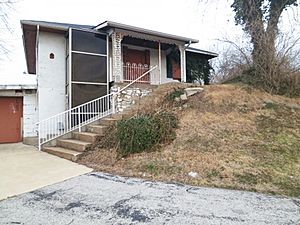Sugarloaf Mound facts for kids
Quick facts for kids |
|
|
Sugarloaf Mound
|
|
 |
|
| Lua error in Module:Location_map at line 420: attempt to index field 'wikibase' (a nil value). | |
| Nearest city | St. Louis, Missouri |
|---|---|
| Area | 1 acre (0.40 ha) |
| NRHP reference No. | 84002689 |
| Added to NRHP | February 17, 1984 |
Sugarloaf Mound is a special place in St. Louis, Missouri. It is the only remaining platform mound built by the ancient Mississippian culture in the city. Long ago, St. Louis was known as "Mound City" because it had about forty of these amazing Native American earthen structures.
Sugarloaf Mound is the last one left from a Native American culture that lived in the St. Louis area between 600 and 1300 A.D. It is also the oldest human-made structure in the entire city of St. Louis!
Contents
History of St. Louis Mounds
St. Louis was once home to many large earthen mounds. These were built by Native American people who lived there long ago. One famous mound, called "Big Mound," was torn down in the mid-1800s. This happened after the land was sold to a railroad company.
Why Mounds Disappeared
More mounds were destroyed when St. Louis prepared for the 1904 World's Fair. About sixteen mounds were removed for this big event. Some mounds in Forest Park were studied by archaeologists. They found evidence of ancient burials there.
Mounds Today
Today, most of the mounds in St. Louis are gone. But you can still see about 80 mounds preserved at the Cahokia Mounds State Historic Site. This important site is just across the Mississippi River in Illinois. Sugarloaf Mound is one of the very few mounds left in St. Louis itself. It is listed on the National Register of Historic Places, which helps protect it.
About Sugarloaf Mound
Sugarloaf Mound got its name in the 1700s. People in St. Louis thought its shape looked like the cone-shaped loaves that sugar used to be shipped in. Even though the mound has not been dug up by archaeologists, it is believed that it was used for burials.
Sugarloaf Mound is about 40 feet (12 m) tall. It measures 100 feet (30 m) from north to south and 75 feet (23 m) from east to west. The mound sits on a hill overlooking the Mississippi River. It is near where Interstate 55 meets South Broadway.
Location and Changes
The mound is now completely inside the city of St. Louis. But it used to be on the border between St. Louis and a smaller city called Carondelet. In 1809, Sugarloaf Mound was used as an important landmark when St. Louis officially became a city.
A house was built right next to Sugarloaf Mound in 1928. Parts of the mound were also changed by a quarry nearby. The building of Interstate 55 also affected the mound. The house on Sugarloaf Mound was still standing in 2013.
Osage Nation's Role
In 2009, the Osage Nation bought the house and land around Sugarloaf Mound. They bought it from a private owner. Their goal was to protect the mound. The house itself had been empty since 2008.
The Osage Nation does not say they built this specific mound. However, they share a similar history of building mounds in the American Midwest. The Osage Nation wants to restore Sugarloaf Mound. They plan to make it look more like it did before buildings were added. In 2017, the Osage Nation was able to remove the old house from the mound.
The Osage Nation hopes to build an interpretive center in the future. This center would be north of the mound. It would help visitors learn more about the mound and its history.


